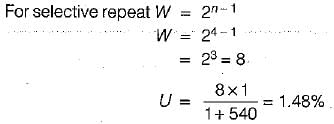Test: Data Link Layer & MAC-Sublayer- 2 - Computer Science Engineering (CSE) MCQ
15 Questions MCQ Test - Test: Data Link Layer & MAC-Sublayer- 2
If an ethernet destination address is 07-01 -12 - 03 - 04 - 05, then that is a _____ address,
If N is the maximum sequence number, then the window sizes in selective reject and Go-Back-N protocols are respectively:
CRC can detect all bursts of upto m errors, if generator polynomial G(x) is of degree
In a Go-back-N ARQ, if the window size is 63, what is the range of sequence numbers?
For stop and wait ARQ, for n data packets sent, ______________ acknowledgments are needed.
In token ring, the tokens can be removed by
Who strips the data frame from the token ring network?
Which of the following indicates the increasing order of accuracy in error detection?
A selective repeat ARQ is using 7 bits to represent the sequence numbers. What is the maximum size of the window?
Which error detection method consists of a parity bit for each data unit as well as an entire data unit of parity bits?
The reference polynomial used in a CRC scheme is x4 + x3 + 1. A data sequence 1010101010 is to be sent, Determine the actual bit string that is transmitted.
A 3000 km long trunk operates at 1.536 mbps and is used to transmit 64 bytes frames and uses sliding window protocol. The propagation speed is 6 μ sec/km.
The minimum number of bits required in the sequence number field of the packet is
A 3000 km long trunk is used to transmit frames using a Go-Back-N protocol. The propagation speed is 6 jasec/ km and trunk data rate is 1.544 Mbps. We ignore the time taken to receive the bits in the acknowledgment. Frame size is 64 Bytes.
What is the maximum number of bits of the sequence number?
A channel has bit rate of 1 Mbps and propagation delay of 270 msec. Frame size is of 125 bytes. Acknowledgment is always piggybacked onto data frames. Four bit sequence number is used, ignore header size.
What is the maximum achievable channel utilization for Go-Back-N?
A channel has bit rate of 1 Mbps and propagation delay of 270 msec. Frame size is of 125 bytes. Acknowledgment is always piggybacked onto data frames. Four bit sequence number is used, ignore header size.
What is the maximum achievable channel utilization for Selective Repeat?


















